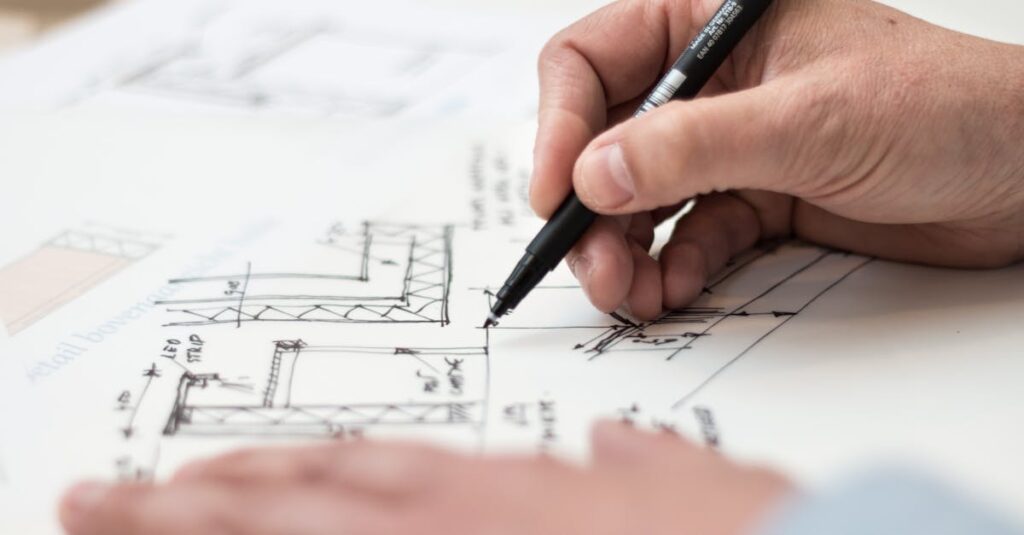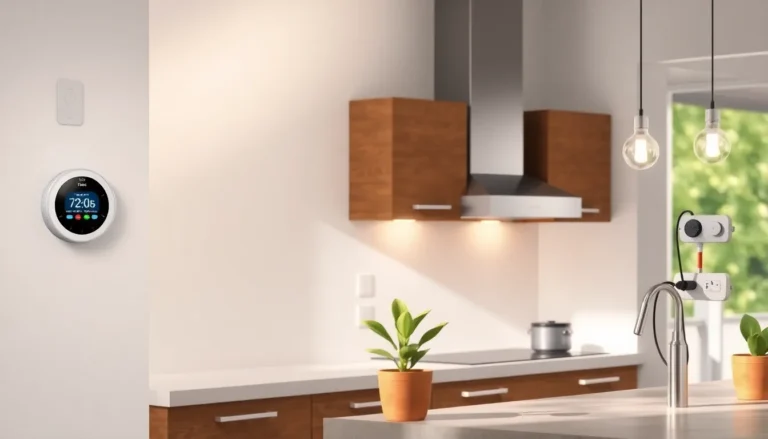Table of Contents
ToggleCivil design concepts are the unsung heroes of our built environment. They’re the brains behind everything from skyscrapers that scrape the sky to bridges that connect communities. Imagine a world where streets are just random potholes and buildings are mere piles of bricks—thankfully, civil design keeps that nightmare at bay.
Overview of Civil Design Concepts
Civil design concepts form the foundation of modern infrastructure. Both functionality and aesthetics play crucial roles in creating structures like bridges, roads, and buildings. Planners consider various factors such as environmental impact and community needs.
Sustainability is a key aspect of civil design, promoting energy-efficient materials and processes. Innovative designs help reduce energy consumption and minimize waste during construction. Planners often incorporate green spaces, enhancing the overall quality of urban life.
Safety remains a priority during the design phase. Engineers use rigorous standards to ensure that structures withstand natural disasters. Regular inspections and maintenance protocols are part of the design process, allowing for long-term durability.
Accessibility is vital for creating inclusive environments. Concepts include ramps, elevators, and clear signage, ensuring that everyone can navigate spaces easily. Attention to these elements makes public areas more welcoming.
Collaboration among various disciplines enriches civil design projects. Engineers, architects, and urban planners work together to balance aesthetics and practicality. Such teamwork leads to cohesive and innovative solutions.
Technology has transformed civil design methodologies. Computer-aided design (CAD) software enables detailed modeling and simulations. This advancement facilitates better planning and helps visualize how projects fit within their surroundings.
Investment in civil design concepts yields economic benefits for communities. Well-designed infrastructure attracts businesses and boosts tourism. Communities that prioritize design often experience enhanced connectivity and improved quality of life.
Key Principles of Civil Design
Civil design encompasses various principles, emphasizing functionality, safety, and sustainability that shape our built environment. These foundational concepts guide the creation of structures that enhance community life and support economic growth.
Functionality and Safety
Functionality remains a critical principle in civil design, ensuring that structures serve their intended purpose efficiently. Designers must assess traffic flow, user access, and operational needs, creating spaces that cater to both everyday activities and emergency scenarios. Safety ranks equally high, as engineers follow strict regulations to ensure structures endure natural disasters like earthquakes or floods. Regular inspections maintain stability and resilience, reflecting an ongoing commitment to public safety.
Sustainability Considerations
Sustainability drives modern civil design, integrating eco-friendly practices into every project. Utilizing energy-efficient materials reduces environmental impact, supporting long-term ecological balance. Planners emphasize the importance of incorporating green spaces, improving urban air quality, and enhancing residents’ well-being. Innovative technologies, such as renewable energy systems, further contribute to sustainable design objectives. To comply with sustainability goals, projects often prioritize efficient resource usage and waste reduction practices throughout their lifecycle.
Types of Civil Design Concepts
Civil design concepts encompass various areas, essential for constructing resilient and efficient infrastructure. Each type plays a pivotal role in the overall success of projects.
Structural Design
Structural design focuses on ensuring that buildings and bridges can support loads safely. Engineers analyze forces, materials, and stability for various structures. They utilize advanced software to create detailed models, allowing for precise calculations. The selection of materials impacts strength and durability. Concrete and steel are popular due to their proven performance. Foundations must also be designed to suit specific soil conditions, ensuring overall integrity. Proper planning in this area prevents structural failures and minimizes maintenance costs.
Geotechnical Design
Geotechnical design addresses the behavior of earth materials and their interaction with structures. This field examines soil properties to determine suitability for foundation design. Engineers conduct soil tests to evaluate strength, compressibility, and drainage characteristics. The findings help determine the best foundation type, such as shallow or deep foundations. They also assess potential settlement issues, ensuring stability over time. Understanding groundwater conditions further enhances design reliability. This careful consideration prevents costly failures and ensures long-lasting structures.
Environmental Design
Environmental design emphasizes the integration of structures with their natural surroundings. This approach focuses on minimizing negative impacts while enhancing ecological value. Strategies include selecting sustainable materials and maximizing energy efficiency. Water management systems are designed to reduce runoff and conserve resources. Designs incorporate green spaces and biodiversity, improving urban environments’ quality. Furthermore, consideration of local climate conditions enables more efficient energy use. Ultimately, this type of design promotes harmony between infrastructure and nature, benefiting communities.
Tools and Technologies in Civil Design
Civil design increasingly relies on advanced tools and technologies to enhance efficiency and accuracy in project execution.
Software Applications
Various software applications play a crucial role in civil design. Computer-aided design (CAD) software allows for precise modeling of structures, ensuring every detail meets specified requirements. Structural analysis programs assess loads and forces on buildings and bridges, allowing engineers to optimize safety. Geographic Information Systems (GIS) help planners visualize and analyze spatial data, streamlining site selection and impact assessments. Additionally, Building Information Modeling (BIM) integrates various aspects of design, construction, and management, fostering collaboration among stakeholders. These applications contribute significantly to creating effective civil infrastructure.
Emerging Technologies
Emerging technologies are transforming civil design practices. 3D printing is making it possible to construct intricate components quickly and cost-effectively. Drones facilitate site inspections, capturing aerial data to streamline project monitoring and enhance safety. Virtual reality (VR) offers immersive experiences for clients, enabling them to visualize projects before construction begins. Furthermore, sensors integrated into infrastructure monitor structural health in real-time, identifying potential issues before they escalate. Each of these technologies contributes to improved design processes, sustainability, and efficiency in civil engineering projects.
Real-World Applications of Civil Design Concepts
Civil design concepts find extensive use in numerous real-world applications, enhancing functionality and aesthetics in projects.
Infrastructure Development
Infrastructure development relies heavily on civil design principles to ensure structures meet specific needs. Roads, bridges, and tunnels are designed with safety and durability in mind, emphasizing load-bearing capabilities. Engineers select high-performance materials and use advanced modeling techniques to optimize designs. For example, the Golden Gate Bridge showcases the importance of structural design, as its design allows it to withstand strong winds and seismic activity. Moreover, sustainability considerations guide the integration of energy-efficient systems and practices into new infrastructure projects, illustrating a commitment to long-term environmental impact.
Urban Planning
Urban planning leverages civil design concepts to create livable spaces that accommodate growing populations. Planners utilize Geographic Information Systems to analyze land use and develop effective transportation networks. Community needs drive decisions regarding parks, public transport facilities, and residential areas. Successful urban planning results in cities like Curitiba, Brazil, known for its efficient bus rapid transit system that reduces traffic congestion and pollution. Further, mixed-use developments blend residential and commercial spaces, promoting walkability and enhancing quality of life in urban settings. Each design choice reflects an emphasis on accessibility and sustainability, ensuring lasting benefits for urban communities.
Civil design concepts are essential for creating infrastructure that meets the needs of modern society. They ensure that structures are not only functional and safe but also environmentally sustainable and aesthetically pleasing. By prioritizing collaboration among engineers, architects, and urban planners, innovative solutions emerge that enhance community life and promote economic growth.
The integration of advanced technologies further enhances the efficiency and accuracy of civil design practices. As urban areas continue to evolve, the importance of thoughtful civil design becomes increasingly clear. Investing in these concepts leads to resilient infrastructure that supports connectivity and improves the quality of life for all residents.







